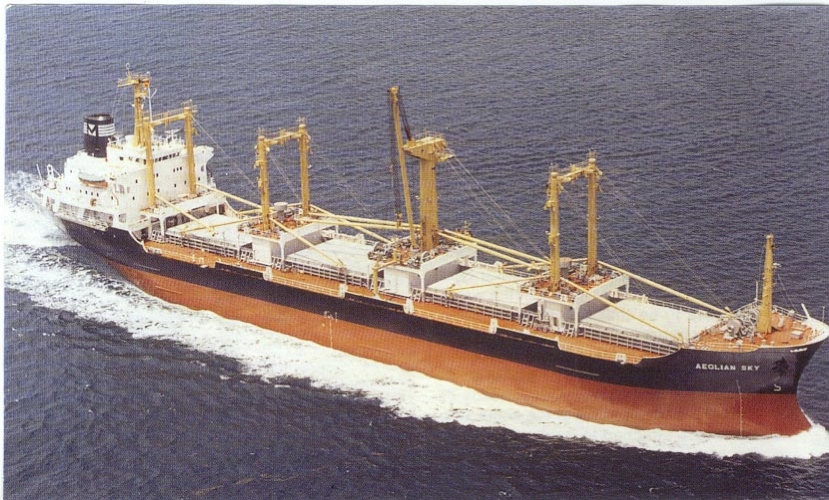
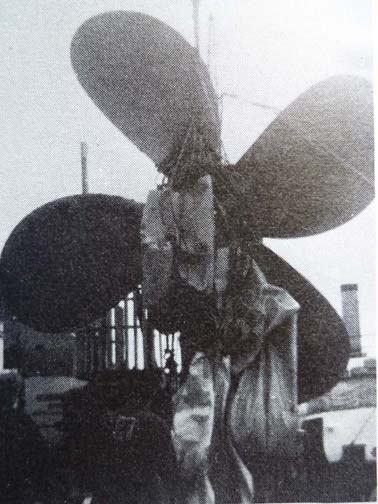
Propellor salvaged from the wreck
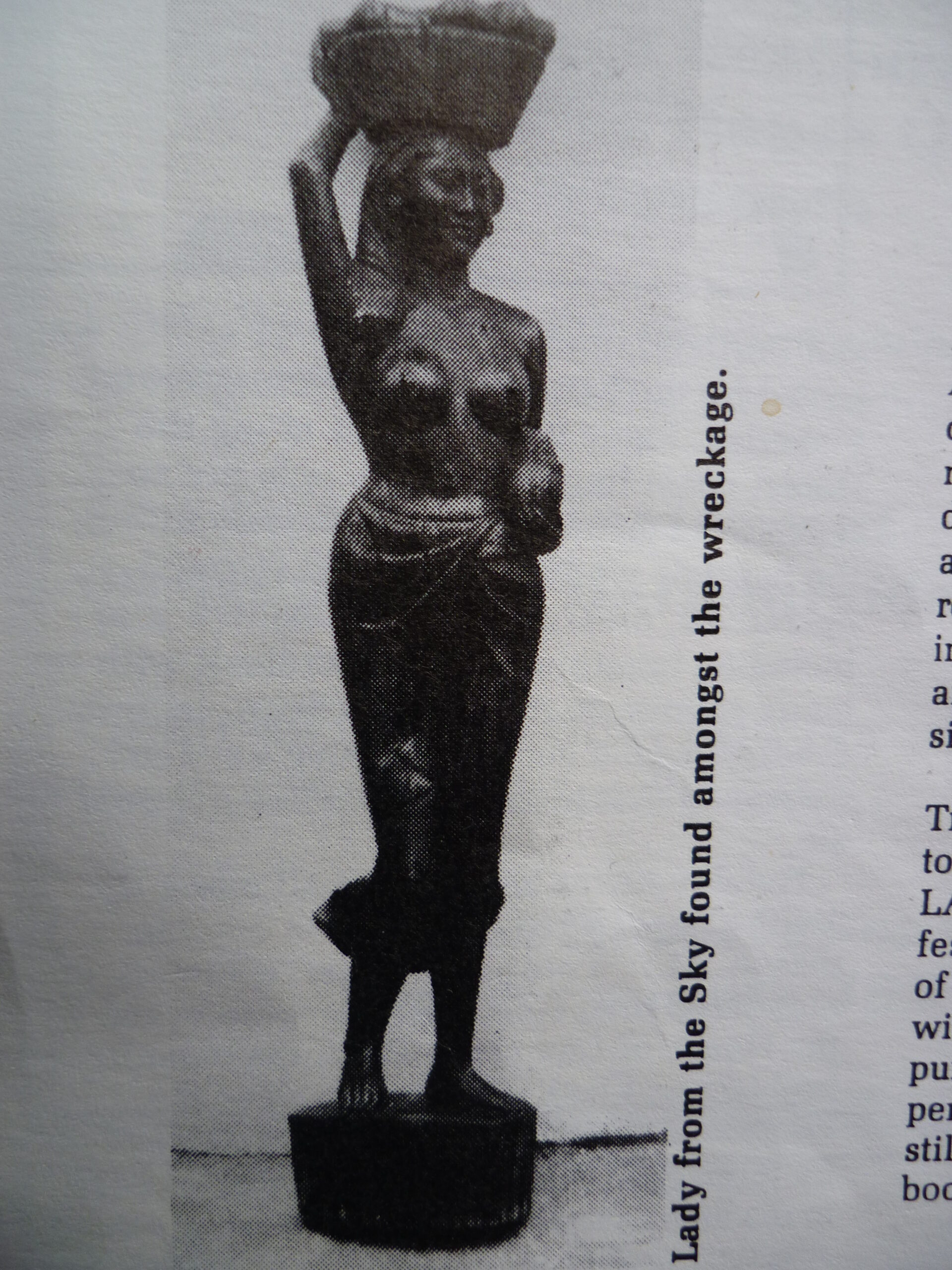
Bronze figure salvaged from the wreck
Greek Freighter [30M] – Detail in Dive Dorset: 200 p149/150: GPS; 50 30.55N; 02 08.33W & Clarke: GPS;50 30.57N; 02 08.42W. (Also in LARN) – Collided with M. V. ANNA KNUPPEL on 03/11/1979. Was taken in tow by French tug ABEILLE LANGUEDOC for Portland Harbour but sank off St Alban’s Head. Very popular at the time for local divers. Most famous for the loss of Seychelles 100 rupee banknotes which went missing. The issue of these notes was subsequently cancelled.
Note by Kendall MacDonald:
She was just a year old, and big with it. Her hull and machinery was valued at over £3 million. That figure didn’t include the cargo with which her holds were stuffed, or the many containers and dozens of Land Rovers on deck. That deck cargo made the 10,715 ton Greek motor vessel AEOLIAN SKY look even bigger, as she headed down the Channel from London for Dar-es-Salaam.
Despite foul weather, the 148m-long ship made good progress until, on 3 November, 1979, she collided with another motor vessel, the West German ANNA KNUPPEL.
The Greek came off worst, badly holed in No 1 hold and flooding so heavily that her bow was almost under water. Her crew were all taken off by helicopters, before a French tug got her in tow and headed for Portland Harbour. Early the next day, the Sky sank amid gale-force winds and huge seas 12 miles off Portland Bill.
Poisonous chemicals in drums were soon being washed ashore along the coast of the Isle of Wight, and a major danger alert was put into operation. The cargo was listed as hundreds of containers of such chemicals plus paint and thinners, liquid chlorine, butane aerosols, Bostik cleaner, ammonia, glass, barbed wire and, of course, Land Rovers.
She was also said to be carrying more than a million pounds in Seychelles rupee bank notes in her sickbay (for want of anywhere else to put them). Most of these are still missing
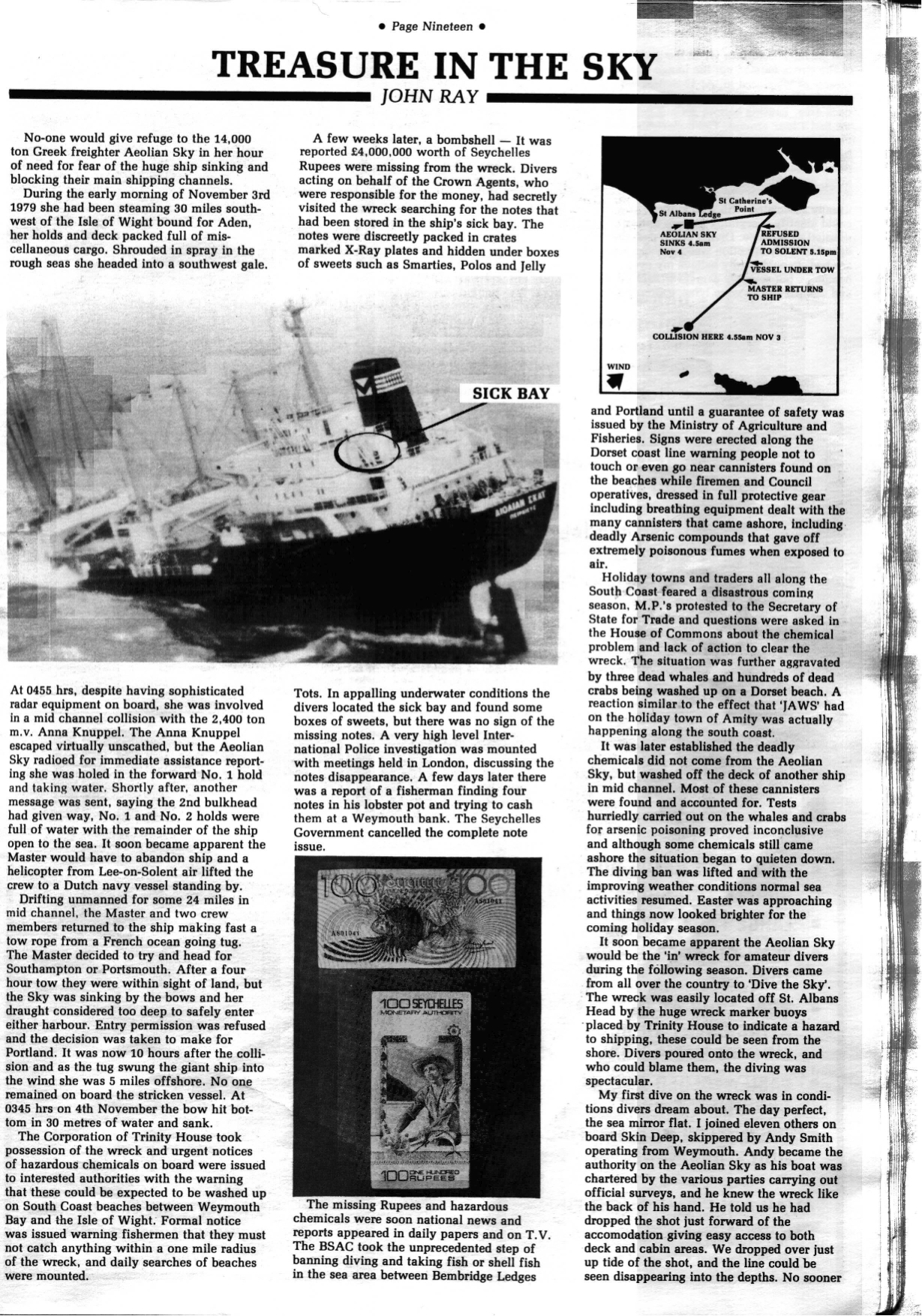
No-one would give refuge to the 14,00 ton Greek freighter Aeolian Sky in her hour of need for fear of the huge ship sinking and blocking their main shipping channels. During the early morning of November 3rd 1979 she had been steaming 30 miles south west of the Isle of Wight bound for Aden, her holds and deck packed full of miscellaneous cargo. Shrouded in spray in the rough seas she headed into a southwest gale.
At 0455 hrs, despite having sophisticated radar equipment on board, she was involved in a mid channel collision with the 2,400 ton m.v. Anna Knuppel. The Anna Knuppel escaped virtually unscathed, but the Aeolian Sky radioed for immediate assistance reporting she was holed in the forward No. 1 hold and taking water. Shortly after, another message was sent, saying the 2nd bulkhead had given way, No. 1 and No. 2 holds were full of water with the remainder of the ship open to the sea. It soon became apparent the Master would have to abandon ship and a helicopter from Lee-on-Solent air lifted the crew to a Dutch navy vessel standing by. Drifting unmanned for some 24 miles in mid channel, the Master and two crew members returned to the ship making fast a tow rope from a French ocean going tug. The Master decided to try and head for Southampton or Portsmouth. After a four hour tow they were within sight of land, but the Sky was sinking by the bows and her draught considered too deep to safely enter either harbour. Entry permission was refused and the decision was taken to make for Portland. It was now 10 hours after the collision and as the tug swung the giant ship into the wind she was S miles offshore. No one remained on board the stricken vessel. At 0345 hrs on 4th November the bow hit bot tom in 30 metres of water and sank. The Corporation of Trinity House took possession of the wreck and urgent notices of hazardous chemicals on board were issued to interested authorities with the warning that these could be expected to be washed up on South Coast beaches between Weymouth Bay and the Isle of Wight. Formal notice was issued warning fishermen that they must not catch anything within a one mile radius of the wreck, and daily searches of beaches were mounted.
A few weeks later, a bombshell. It was reported £4,000,000 worth of Seychelles Rupees were missing from the wreck. Divers acting on behalf of the Crown Agents, who were responsible for the money, had secretly visited the wreck searching for the notes that had been stored in the ship’s sick bay. The notes were discreetly packed in crates marked X-Ray plates and hidden under boxes of sweets such as Smarties, Polos and Jelly Tots. In appalling underwater conditions the divers located the sick bay and found some boxes of sweets, but there was no sign of the missing notes. A very high level International Police investigation was mounted with meetings held in London, discussing the notes disappearance. A few days later there was a report of a fisherman finding four notes in his lobster pot and trying to cash them at a Weymouth bank. The Seychelles Government cancelled the complete note issue.
The missing Rupees and hazardous chemicals were soon national news and reports appeared in daily papers and on T.V. The BSAC took the unprecedented step of banning diving and taking fish or shell fish in the sea area between Bembridge Ledges and Portland until a guarantee of safety was 1ssued by the Ministry of Agriculture and Fisheries. Signs were erected along the Dorset coast line warning people not to touch or even go near cannisters found on the beaches while firemen and Council operatives, dressed in full protective gear including breathing equipment dealt with the many cannisters that came ashore, including deadly Arsenic compounds that gave off extremely poisonous fumes when exposed to air. Holiday towns and traders all along the South Coast feared a disastrous coming season. M.P.’s protested to the Secretary of State for Trade and questions were asked in the House of Commons about the chemical problem and lack of action to clear the Wreck. The situation was further aggravated by three dead whales and hundreds of dead crabs bein8 washed up on a Dorset beach. A reaction similar to the effect that JAWS had on the holiday town of Amity was actually happening along the south coast. It was later established the deadly chemicals did not come from the Aeolian Sky, but washed off the deck of another ship in mid channel. Most of these cannisters were found and accounted for. Tests hurriedly carried out on the whales and crabs for arsenic poisoning proved inconclusive and although some chemicals still came ashore the situation began to quieten down. The diving ban was lifted and with the improving weather conditions normal sea activities resumed. Easter was approaching and things now looked brighter for the coming holiday season. It soon became apparent the Aeolian Sky would be the in’ wreck for amateur divers during the following season. Divers came from all over the country to Dive the Sky’. The wreck was easily located off St. Albans Head by the huge wreck marker buoys placed by Trinity House to indicate a hazard to shipping. these could be seen from the shore. Divers poured onto the wreck, and who could blame them, the divin8 was spectacular. My first dive on the wreck was in conditions divers dream about. The day perfect, the sea mirror flat. I joined eleven others on board Skin Deep, skippered by Andy Smith operating from Weymouth. Andy became the authority on the Aeolian Sky as his boat was chartered by the various parties carrying out official surveys, and he knew the wreck like the back of his hand. He told us he had dropped the shot just forward of the accommodation giving easy access to both deck and cabin areas. We dropped over just up tide of the shot, and the line could be seen disappearing into the depths. No sooner had we left the surface when the dark shape of the wreck loomed up: the image becoming clearer as we closed in. At 12 metres we ere holding onto the guard rail around the deck area. Pausing here to get our bearings we had a look around. The underwater visibility was superb. The ship was lying on her port side and the first impression was one of cleanliness and near perfect conditions, everything looked as good as new, no marine growth, no rusting or twisted plates usually associated with wreck dives, you could identify everything seen -a most unusual experience. Diving down past the open holds my attention was attracted to the sea bed, I could hardly believe my eyes. complete, but severely damaged Land Rovers and dumper trucks were lying scattered over the sea bed, surrounding them were wooden crates containing engines, all completely ruined after six months in the sea. The sea bed was littered with debris, rolls of string, glass bottles by the thousand, rolls of material (mens suits have been made with some of the material raised) various containers and boxes, the sight was endless, toc much to absorb in the mind with so much to see. Entering one of the enormous holds it was full of tyres of all shapes and sizes, from huge tractor types to small truck tyres, they were even overhead where they had trapped air and become buoyant, wedging themselves against the starboard side of the vessel now above us. Finning past the accommodation areas, (noting they were only aluminium portholes) peering into doorways and walkways it was hard to image how anyone could have found their way around in zero visibility as it was when the divers were looking for the missing notes. The dive was now approaching its end but I could no leave without seeing the prop. Indicating to my buddy we finned to the stern of the ship. Dropping over the stern past the name Aionian Ckat, it came into view, a magnificent four bladed bronze prop at least 5 metres in diameter-a salvage diver’s dream. Giving it a fond tap it was time to go and as the wreck disappeared below it was replaced by a view of the surface glistening in the sunlight overhead. Breaking surface and seeing Skin Deep turn to pick us up signified the end of a perfect dive. Since then a lot has happened to the Sky. Trinity House let a contract to Cosag Diving to blow the wreck apart to give a minimum L.AT clearance of 17 metres. A local professional diver Peter Knight (also a member of Weymouth & Portland BSAC) who worker with Cosag invested money and time and purchased the salvage rights for a three year period. The prop was removed, but there is still thousands of pounds worth of salvage booty on the wreck. most now buried under tons of platework. A few of the rupees did turn up, found scattered amongst the debris on the sea bed, but the mystery of the missing millions still remains. It was estimated the insurance claim for the wreck and cargo was in excess of £40,000,000 The Wreck is still a very popular dive, and who knows, maybe you will be the one to find the rest of the missing millions!
Salvage short list still waiting to be raised
- Locomotive
- Concrete mixer
- Exercise bikes
- Perfume
- Wine
- Barometers
- Diesel engines
- Bull dozer
- Bank vault
- Revolvers
- Billiard tables
- Medicines
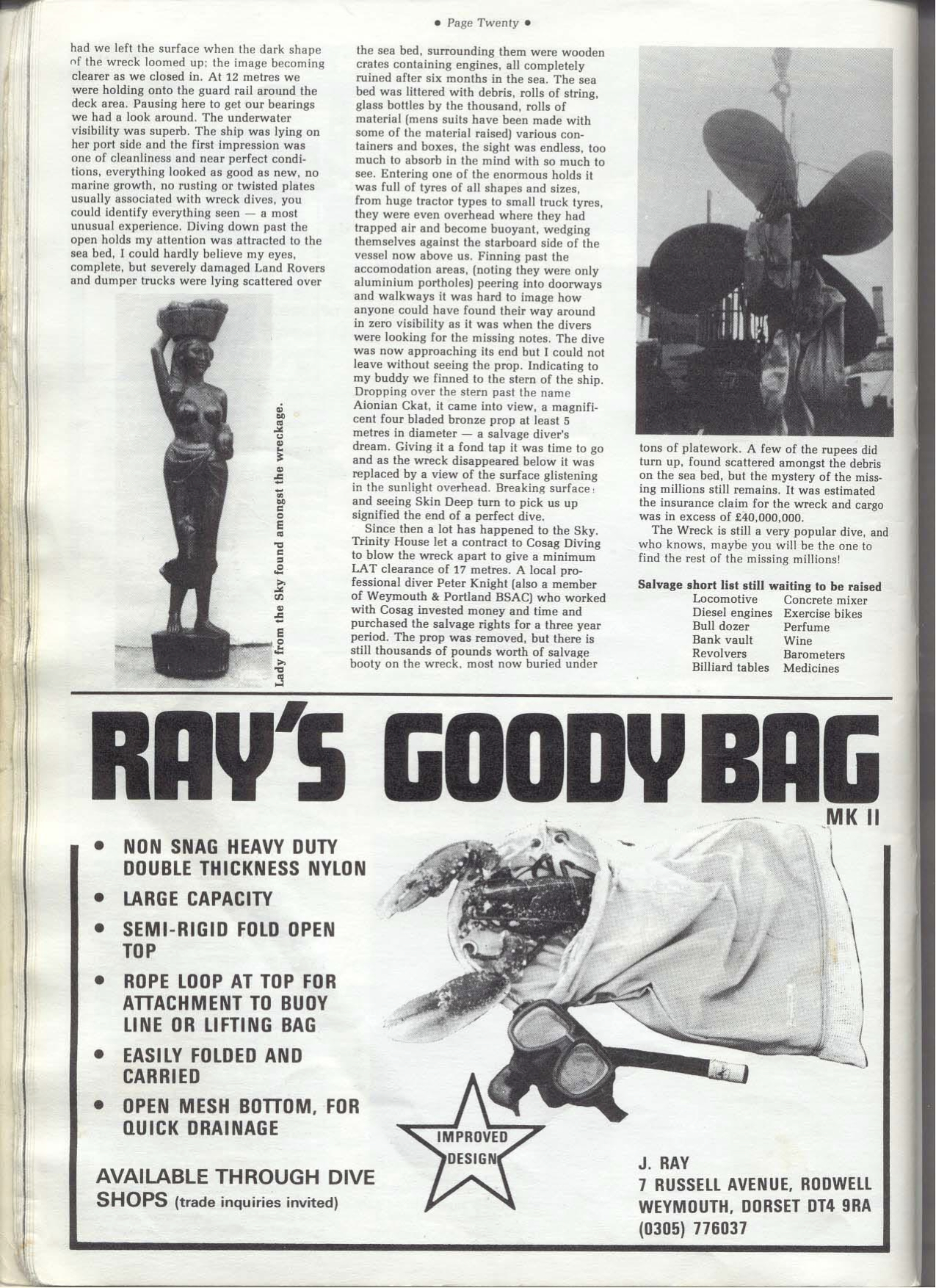
Reference:
Grahame Knott database
Day of Loss: 4
Month of Loss: 11
Year of Loss: 1979
Longitude: 50 30.55
Latitude: 02 08.33
Approximate Depth: 30
